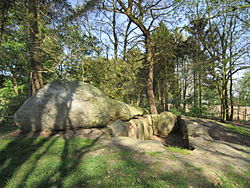Passage grave of Ostenwalde
| Passage grave of Ostenwalde | ||
|---|---|---|
|
Passage grave from Ostenwalde, looking east |
||
|
|
||
| Coordinates | 52 ° 50 '14.3 " N , 7 ° 35' 23.6" E | |
| place | Ostenwalde , Lower Saxony , Germany | |
| Emergence | 3500 to 2800 BC Chr. | |
| Sprockhoff no. | 835 | |
The Ostwalde passage grave is a megalithic complex in Ostenwalde in the town of Werlte , in the Emsland district in Lower Saxony . The large stone grave is under the Sprockhoff no. Registered in 835 and part of the Route of the Megalithic Culture . The megalithic complex from the Neolithic was created by the funnel beaker culture (TBK) between 3500 and 2800 BC. Built in BC. The passage grave is a form of Neolithic megalithic systems, which consists of a chamber and a structurally separated, lateral passage. This form is primarily found in Denmark, Germany and Scandinavia, as well as occasionally in France and the Netherlands. Neolithic monuments are an expression of the culture and ideology of Neolithic societies. Their origin and function are considered to be the hallmarks of social development.
description
The passage grave is not its original location, but in 1971 east of the former site of the after scientific study and restoration by about 70 meters country road L53 added . After attempts to cleanly put the capstones back on had failed, the chamber was left open to provide an insight into the construction technology of the very well-preserved megalithic complex. The chamber is roughly west-east oriented. All 14 bearing stones are present - two have been added. The five cap stones (one is split) are next to the system. The entrance is about in the middle of the southern long side. Gang stones have not been preserved. The chamber has an internal length of 8.5 meters and a width of 1.8 meters. It cannot be determined whether the complex originally had edging stones and a hill.
During the investigation in 1971 numerous finds of ceramics and stone utensils of the funnel beaker culture were made. It was also possible to prove that several subsequent burials were carried out in the late Neolithic period .
See also
- Nordic megalithic architecture
- The complex is on the street of the megalithic culture
literature
- Anette Bußmann : Stone Age witnesses. Travel to the prehistory of northwest Germany. Isensee Verlag, Oldenburg 2009, ISBN 978-3-89995-619-1 , pp. 73-74.
- Mamoun Fansa : large stone graves between Weser and Ems . Isensee Verlag, Oldenburg 1992, ISBN 3-89442-118-5 , pp. 50-51.
- Ernst Sprockhoff : Atlas of the megalithic tombs Germany. Part 3: Lower Saxony - Westphalia. Rudolf Habelt Verlag, Bonn 1975, ISBN 3-7749-1326-9 , pp. 95-96.
Web links
Individual evidence
- ↑ J. Müller In: Varia neolithica VI 2009 p. 15


